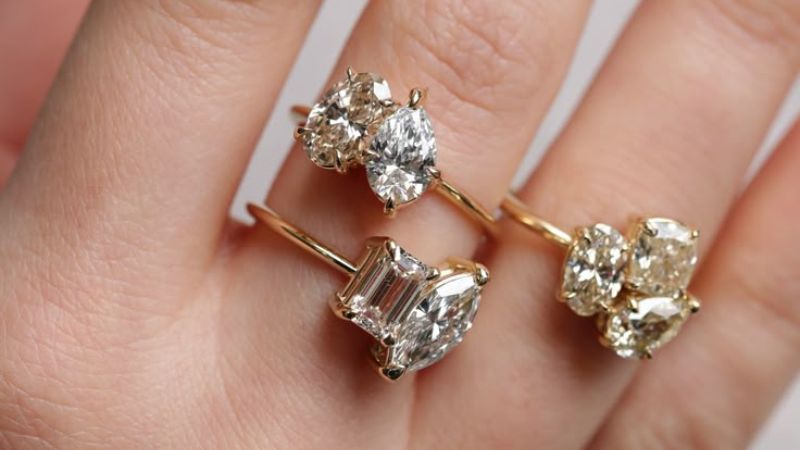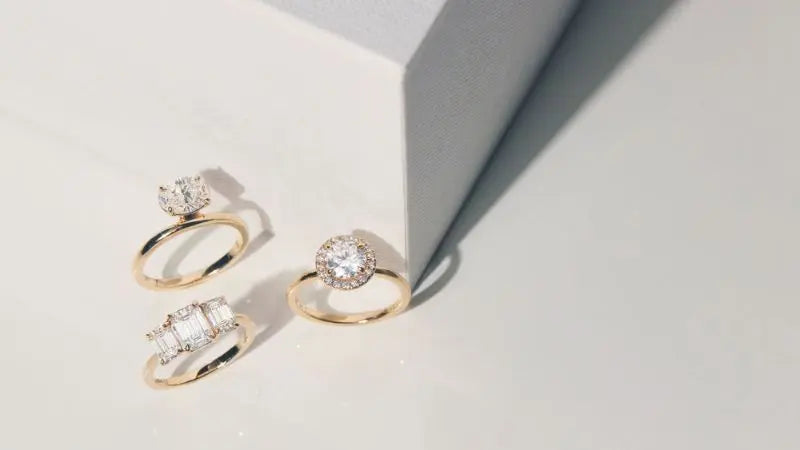Up To $2,500 OFF at checkout - Ends Dec 12
Free 30-day Returns | Lifetime Warranty
We’ll explore everything you need to know about flush diamond rings and why they are an ideal choice for anyone looking for a timeless and practical ring.
1. Introduction
An engagement ring isn’t just about the diamond—it’s about the setting, too. A flush-set engagement ring offers durability, security, and modern elegance in a sleek, low-profile design.
But what sets this style apart? This guide covers everything you need to know about flush diamond rings and why they’re a practical, timeless choice.
>> See more: Engagement Ring Settings Explained: Pros and Cons of Every Type
2. What is a Flush-Setting Engagement Ring?
2.1. Definition and Basics
A flush setting, also called a gypsy setting, embeds the diamond or gemstone directly into the metal band.
Unlike prong or bezel settings, which elevate the stone, a flush setting keeps it level with the metal’s surface, creating a smooth, seamless finish.

Flush setting engagement bands
2.2. How It Works
Crafting a flush setting requires precision:
- The jeweler drills a hole in the metal to fit the stone snugly.
- They shape and press the surrounding metal over the stone to secure it.

The craftsmanship of flush setting
This technique enhances durability while maintaining a sleek, minimalist aesthetic.
3. Types of Flush-Setting Engagement Rings
3.1. Asymmetrical Flush Setting
A modern take on the classic flush setting, this design features scattered diamonds placed in an off-center pattern. It adds an artistic touch while maintaining durability.

The flush lab-grown diamond dome ring
3.2. Classic Flush Setting
The traditional flush setting keeps the diamond completely level with the metal, offering a subtle yet refined look—ideal for those who value understated elegance.

The classic flush engagement rings with oval stone
3.3. Beveled Flush Setting
This variation adds a slight bevel around the stone, giving it depth and dimension. The beveled edge enhances light reflection, making the diamond appear slightly larger.
A flush-set engagement ring blends beauty with functionality, making it an excellent choice for those who value style and durability.

The cushion-cut diamond solitaire engagement ring with beveled flush setting
4. The Benefits of Flush-Setting Engagement Rings
A flush setting offers a perfect balance of aesthetics and practicality, with several key advantages:
4.1. Exceptional Durability
With the stone embedded into the metal, there are no exposed edges or prongs that can bend or break. This makes it an ideal choice for active lifestyles.
4.2. Modern and Minimalist Aesthetic
The clean, streamlined design suits those who prefer contemporary elegance. The diamond sits flush with the band, creating a subtle, sophisticated look.
4.3. Secure and Low-Maintenance
By securing the diamond within the metal, a flush setting reduces the risk of loosening or loss. Unlike prong settings, it requires minimal upkeep.
4.4. Versatile Design Options
A flush setting works well with various metals like platinum, white gold, yellow gold, and rose gold. It also complements different diamond shapes and sizes, allowing for custom, unique designs.
4.5. Comfortable for Daily Wear
Its smooth, snag-free surface prevents catching on fabric or hair, making it a comfortable, hassle-free option for everyday use.
5. Flush Setting vs. Other Popular Engagement Ring Settings
A flush setting offers a secure, modern, and low-maintenance alternative to traditional styles. Here’s how it compares:
5.1. Prong Setting
Prongs hold the diamond above the band, allowing maximum light reflection for brilliance. However, exposed edges make the stone vulnerable to snags, bending, or damage—requiring frequent maintenance.

The solitaire Maia cushion lab diamond ring in prong setting
5.2. Bezel Setting
A bezel fully surrounds the stone with metal, providing superior protection. However, the extra metal can reduce brilliance and appear bulkier compared to a flush setting’s sleek, integrated look.

The bezel Helena cushion solitaire moissanite ring in bezel setting
5.3. Pavé Setting
Pavé rings use small diamonds set closely together with tiny metal beads, creating a continuous sparkle. While dazzling, pavé settings lack durability—small stones are more prone to loosening or loss compared to a flush-set diamond.

The Lenny round lab diamond ring in pavé setting
6. Maintaining and Cleaning Flush-Set Jewelry
6.1. Routine Maintenance Tips
Keep your flush-set jewelry pristine with regular care:
- Inspect for loose stones or scratches to ensure long-term durability.
- Clean with a soft brush and mild soap to remove dirt and oils.
- Avoid wearing it during strenuous activities or when handling harsh chemicals.
6.2. Professional Cleaning and Check-Ups
For deeper cleaning and structural integrity:
- Jewelers use ultrasonic cleaners and steam cleaning to remove built-up debris safely.
- Regular inspections help detect wear before issues arise, ensuring lasting security.
7. Frequently Asked Questions (FAQs)
Question 1: What tools are essential for flush setting gemstones?
You need a drill, burnisher, hammer handpiece or punch, and a jeweler’s loupe for precise placement and security.
Question 2: How does flush setting differ from gypsy setting?
A flush setting keeps the stone level with the band for a smooth, seamless look. A gypsy setting sinks the stone deeper into the metal, partially covering its edges for enhanced security.
Question 3: How do you remove a flush-set stone?
Push the stone from the underside if possible. If not, carefully drill around it to loosen it. Precision is key to avoiding damage.
Question 4: How do you flush set a stone by hand?
- Drill a hole slightly smaller than the stone’s diameter.
- Create a secure seat for the stone to rest in.
- Gently tap the surrounding metal with a hammer handpiece to lock it in place.
Question 5: Can square or cabochon stones be flush set?
Yes, but they require careful shaping of the seat to fit snugly and prevent tilting or movement.
8. Conclusion
A flush diamond engagement ring is a perfect blend of durability, elegance, and practicality. Whether featuring a single flush-set diamond or multiple stones, this setting offers a modern, sophisticated look with lasting security.
For those who love minimalist, low-maintenance jewelry that withstands daily wear, a flush-set engagement ring is an ideal choice.




